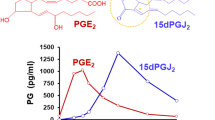Abstract:
In addition to housekeeping cyclooxygenase (COX)-1, which is constitutively expressed in many body cells, an inducible COX-2 has been described and cloned. Induction or presence of COX-2 has been reported not only in isolated cells, but also in cells in various tissues, as well as in both physiological and pathophysiological states, including acute exudative inflammation, proliferative inflammation, animal arthritis, rheumatoid arthritis, angiogenesis, bone absorption, gastric ulcer, colon cancer, hyperalgesia, Alzheimer's disease and certain states of the kidney, brain and female reproductive organs. This review article introduces results from recent works in these fields. COX-1- or COX-2-knockout mice may provide many clues on the roles of COX-2, but may simultaneously cause unnecessary confusion in the recognition of the roles of COX-2, and this is discussed. Recently the roles of COX-2 in exudative inflammation and the anti-inflammatory effects of selective COX-2 inhibitors have been questioned. This is discussed in the text. Prostanoids mediate signals to adjacent cells to provide fine regulation of cellular function. Because of the short duration of the expression of COX-2 gene and protein, COX-2 must play some roles different from those of COX-1 gene and protein in vivo. It is not yet possible to identify all the roles of COX-2, but in some tissues, such as the kidney, the brain and others, COX-2 may be expressed constitutively, whereas the prostaglandin generation by COX-2 may replace that by COX-1 in some states (or vice-versa). Precise analyses of the expression of COX-2 may disclose fine modulation of cellular and organ functions by PGs. Several selective or preferential COX-2 inhibitors have been developed and were shown to be effective in clinical trials. Most were reported to be free of adverse gastrointestinal effects, but it should be noted that in the healing process of gastric ulcers and in sodium-restricted states, adverse effects of selective COX-2 inhibitors could be expected. Soon, with more detailed knowledge of the delicate roles of COX-2 in vivo, effective and safe application of COX-2 inhibitors should be realized.
Similar content being viewed by others
Author information
Authors and Affiliations
Additional information
Received 26 August 1999; returned for revision 6 October 1999; accepted by M. J. Parnham 29 February 2000
Rights and permissions
About this article
Cite this article
Katori, M., Majima, M. Cyclooxygenase-2: its rich diversity of roles and possible application of its selective inhibitors. Inflamm. res. 49, 367–392 (2000). https://doi.org/10.1007/s000110050605
Issue Date:
DOI: https://doi.org/10.1007/s000110050605




